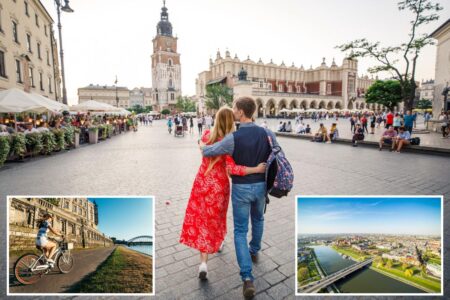Shannon Buck was starting to feel hopeless.
For four years, sheŌĆÖd been trying to have a baby with husband Ryan ŌĆö┬Ābut natural conception, which seemed to come so easily to everyone around them, and sometimes even accidentally, just wasnŌĆÖt happening for the would-be parents.┬Ā
So, in April 2024, the Austin, Texas, couple boarded a packed flight to Istanbul ŌĆö joining men traveling to Turkey for cheap hair transplants and women chasing bigger breasts at smaller prices ŌĆö embarking on a nearly 6,500-mile and weeks-long journey to undergo in vitro fertilization (IVF) treatments.┬Ā
ŌĆ£IVF in America is just so expensive,ŌĆØ Shannon, 35, a health insurance agent, told The Post.┬Ā
ŌĆ£I researched how much cheaper it is in Turkey,ŌĆØ she said. ŌĆ£I found myself making a slideshow presentation for Ryan titled, ŌĆśReasons we need to go to Turkey for IVF.ŌĆÖŌĆØ
At the top of her list? The $4,000 cost of the procedure at the Bahceci Fertility Clinic, ranked one of the top IVF clinics in the world by Newsweek ŌĆö┬Āand certainly one of the more affordable, considering the average price of $25,000 per cycle in the United States.
Shannon and Ryan, 39, an architect, are among the growing number of hopefuls pursuing the dream of destination fertilization ŌĆö┬Ājetting off to parts unknown in search of accessible assisted reproductive care.┬Ā
ItŌĆÖs a market projected to reach $6.18 billion by 2030, owing to the budget-friendly offerings in countries such as Turkey, Spain, the Czech Republic, India and more, per a recent report.┬Ā
Here in the United States, in a bid to ŌĆ£drasticallyŌĆØ boost affordability, President Donald Trump signed an executive order last February to expand ŌĆ£reliable accessŌĆØ to IVF, ŌĆ£including by easing unnecessary statutory or regulatory burdens.ŌĆØ Just last month, the White House announced an agreement with Merck KGaAŌĆÖs U.S. arm, EMD Serono, to offer IVF drugs at ŌĆ£very, very heavily reduced prices,ŌĆØ the president said, via the administrationŌĆÖs pending TrumpRx plan.
In the meantime, many Americans struggle with IVF ŌĆö the creation of an embryo in a lab ŌĆö financially, physically and emotionally. It is a lengthy, multistep process that doesnŌĆÖt just happen over a long weekend out of town. It can take several weeks and require careful monitoring.
The Bucks spent a whole month in Turkey, taking off work and living in an Airbnb during treatment. They spent roughly $20,000 on round-trip flights, food, lodging and IVF in total.
Mothers-in-the-making like Shannon must begin taking hormonal injections 10 to 12 days before the procedure. Then thereŌĆÖs the egg retrieval and freezing, sperm collection, embryo fertilization, and either a fresh or frozen embryo transfer into the uterus.┬Ā
The pair took all those things into consideration before selecting Dr. G├╝rkan Bozda─¤ of the Bahceci Clinic, which uses AI technologies to select the best-quality egg and sperm for the procedure.┬Ā
While there was a ŌĆ£hugeŌĆØ language barrier, Shannon admitted, an English-speaking care coordinator smoothed the way, she said.
The trip ultimately saved the pair $5,000 and gave them their now 10-month-old son.┬Ā
ŌĆ£ItŌĆÖs unbelievable ŌĆö I almost still canŌĆÖt believe it,ŌĆØ Shannon gushed, calling their journey ŌĆ£the best decision IŌĆÖve ever made.ŌĆØ
Jaime Knopman, a board-certified reproductive endocrinologist in Manhattan, told The Post she understands the urge to go abroad ŌĆö┬Ābut advises against it, even if the price is right.
ŌĆ£Of course, itŌĆÖs less expensive,ŌĆØ said the author and director of Fertility Preservation for CCRM Fertility New York. ŌĆ£But IVF regulations in the US ŌĆö infectious disease screening, genetic testing, how we maintain our tanks and patientsŌĆÖ tissues ŌĆö are set to ensure safety and quality. Those guidelines arenŌĆÖt as strict across the world.ŌĆØ
Jessica Hodges heard all the warnings before jetting off to Greece to begin her own journey to parenthood,┬Āwhere she told The Post the cost and quality of care at Ark IVF were ŌĆ£significantly betterŌĆØ than her initial IVF experience in her hometown of Seattle.
ŌĆ£The way theyŌĆÖre monitoring the embryos and how my body is responding to certain medications is incredible,ŌĆØ said the professional baker and married mom of one. ŌĆ£And my embryo quality is far more superior than the results that I had stateside.ŌĆØ
She and husband Phillip first pursued IVF at a local facility in April 2022, after almost a decade of unsuccessfully going it alone.┬Ā
Jessica depleted her 401(k) savings for $30,000 treatment, not including the additional $7,500 she paid for medication and $8,000 for genetic testing. She welcomed a son, Julian, in January 2023.┬Ā┬Ā
But the nearly $50,000 charge was one Jessica, who wants four children, wasnŌĆÖt prepared to re-incur.┬Ā
So to realize her big family dreams without breaking the bank, she laid out $10,000 for a three-week stay in Athens.
ŌĆ£You get IVF and a vacation at a fraction of the cost,ŌĆØ said Jessica, adding that the procedure cost $5,100 ŌĆö and just one moment of embarrassment.┬Ā
ŌĆ£Everyone in Athens speaks English, but obviously not perfectly,ŌĆØ said Jessica, recalling an awkward encounter at the clinic. ŌĆ£The nurse said IŌĆÖd do my egg retrieval while my husband gave his sperm sample. And I was like, ŌĆśWhoŌĆÖs going to watch Julian?ŌĆÖŌĆØ
ŌĆ£The nurse said, ŌĆśYour son can join your husband,ŌĆÖŌĆØ Jessica chuckled at the suggestion that their toddler would accompany Phillip during the private occasion. ŌĆ£Thankfully, another nurse explained that thereŌĆÖd be overlap between the time I came out of recovery and PhillipŌĆÖs deposit.ŌĆØ
The Hodges ŌĆö now back in Washington ŌĆö havenŌĆÖt announced the results of their IVF excursion.
But JessicaŌĆÖs already planning future pregnancy pilgrimages to Greece, where theyŌĆÖve stored embryos for $500 per year (less than the $1,020 annual cost to keep them on ice in Seattle).┬Ā┬Ā
ŌĆ£I can do this exact trip three times before it costs as much as I paid for IVF in America,ŌĆØ she said. ŌĆ£And IŌĆÖll do it again and again.ŌĆØ
Sierra Ochieng, 31, a Michigander currently in Nairobi, Kenya, for fertility support, is also prepared to make repeat trips to Africa as she and husband Michael, 45, grow their family. ┬Ā┬Ā
ŌĆ£We were quoted $29,000 for one IVF cycle in Michigan, but the clinician wasnŌĆÖt┬Āattentive,ŌĆØ said Sierra, a field marketer. ŌĆ£Compared to the treatment IŌĆÖm receiving at The Nairobi IVF Centre, itŌĆÖs like night and day.ŌĆØ
She and Michael ŌĆö a native Kenyan and father to a 15-year-old, Isaac, from a previous relationship ŌĆö spent a total of $10,000 on treatment, flights and lodging for their four-month stay abroad.
They plan to return to the Midwest ŌĆö hopefully pregnant ŌĆö in January.┬Ā
Until then, Sierra is detailing her international IVF experience online, inspiring others to think beyond US borders.┬Ā┬Ā
ŌĆ£YouŌĆÖre not limited to unreasonable costs,ŌĆØ she told The Post. ŌĆ£ThereŌĆÖs life outside of America.ŌĆØ
ŌĆ£You can have a child. Your dream is accessible.ŌĆØ
Brian Levine, a founding partner of CCRM Fertility, another US-based IVF provider, told The Post he encouraged potential IVF travelers to thoroughly evaluate a facilityŌĆÖs success rate, staff qualifications and areas of expertise before surgery.┬Ā
ŌĆ£The procedure carries inherent risks, including those related to egg retrieval, ovarian hyperstimulation syndrome (OHSS) and multiple pregnancies,ŌĆØ he told The Post.
Here are Dr. LevineŌĆÖs top tips for pursuing IVF abroad:┬Ā
- Success Rates: Seek clinics that provide transparent and up-to-date success rates for live births, ideally categorized by age groups and specific medical conditions. Keep in mind that success rates alone do not provide the full picture, as they are influenced by numerous factors.
- Staff Qualifications: Ensure that both the physicians and embryologists have the necessary qualifications and extensive experience. Verify their certifications and board specializations, particularly in reproductive endocrinology and infertility.
- Medical Compatibility: Determine whether the clinicŌĆÖs expertise aligns with your specific medical needs. Some clinics specialize in particular cases, such as patients with a history of failed IVF cycles, which may be critical to your success.
Read the full article here














